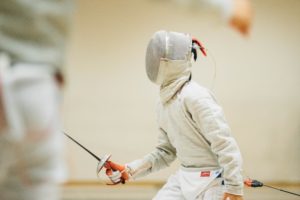Main Menu
Latest Blog Entry
User login
Introducing fitness to fencers.
Fencers physical development should stay one step ahead of skill development.
 That was the theme behind the “Fit for fencing” sessions I ran at the South West Fencing Hub.
That was the theme behind the “Fit for fencing” sessions I ran at the South West Fencing Hub.
My experience of current fencers is that they specialise in fencing early, with little or no background in other sporting activity.
Part of Long Term Athlete Development (LTAD) is the acquisition of a breadth of physical skills at an early age. Without that physical development, skill development is hampered later on.
An example being that fencers are constantly being told to “sit in your stance” or “relax your shoulders”. The fencers I worked with at the hub had very tight Thoracic spines (T-spine, or T-Bone as they insisted on calling it) as well as stiff hips on the non-dominant side.
The tight T-spine meant that when trying to lunge and reach (see video below), they were compensating with extra shoulder work, the opposite of what the coach wanted.
The stiff hip meant that they found it difficult to keep their hips level when moving along the piste and tended to stand up, or tilt forward, thus exposing their head to their opponent.
Posture, balance, control, mobility.
These are the cornerstones of agility and most athletic movement. I showed the fencers 5 different exercises and got them to assess each other using a 5 point marker for each.
The idea was to give them an eye as to what to look for, how it feels and the key coaching points. They have to be able to take it away and practice at home. I also benchmarked a 5/5 (if we had any!) and a 2/5 too, looking for ways to help that person improve.
One of the examples was the Wall Angels that you can see in this video:
However, all of this is worthless if the fencers continue to stand with poor posture on one leg throughout the day.
Warm-ups and cool-downs for fencing.
I used the warm-up to assess their movement and get them ready to acquire a skill. It took the first 20 minutes to get them to walk correctly, then we introduced silly walks, skipping, prone series, 6-way lunges and jackknives.
Due to the sport’s ipsilateral nature, the cooldown for fencers has to be specific. We have to return them to a resting state where they can move normally.
Further reading
- How to warm-up for fencing
- Leg strength and power for fencing
- Should fencers run to get fit?
- How to cool down after fencing
Thanks to all the coaches who answered my questions about the sabre and foil, the weapons I am least familiar with.
Client Testimonials
James is an excellent and experienced Strength and Conditioning Coach. He is able to draw on these experiences to adapt and meet each client’s specific needs. James is known for his engaging and dynamic style that has proved effective in producing results. Having worked with James, he is both organized and efficient. He also is an evidence based practitioner happy to engage in debate and take on new ideas. James rightly demands high standards and a good work ethic which reflects his own contribution to each situation
More


Comments
[…] Introducing fitness to fencers, fencing is a one sided sport, so fencers need special attention to preevnt imbalances and injury, […]
[…] and improve. The discussions I had with the coaches and the information they shared about fencing fitness will help my work with the SW fencing […]
[…] Fencing: SW Fence Hub “Introducing fitness to fencers“ […]
[…] (see picture to right and note one legged standing, similar to that of fencers!) […]
[…] Where to start getting fit for fencing […]
[…] repeated efforts, talking to the fencers about their posture, they still resort to hanging on one leg. As you can see from this rogues […]